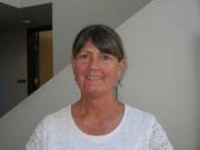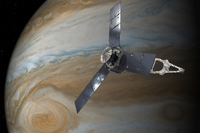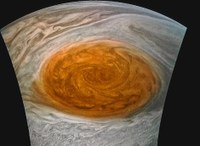Bullitt Lecture 2017 - JunoCam: Pictures of Jupiter from a new Perspective
| When |
Oct 26, 2017
from 06:30 PM to 07:30 PM |
|---|---|
| Where | Gheens Science Hall & Rauch Planetarium |
| Add event to calendar |
|
The Physics & Astronomy Department’s Bullitt Lecture is a free lecture aimed at the general public. Since 2001, the Physics & Astronomy Department’s Bullitt Lecture has presented a distinguished astrophysicist to a Louisville audience in the Gheens Science Hall and Rauch Planetarium. Gale Christianson, Hubble's biographer at Indiana State, Fred Espenak, an eclipse expert at NASA Goddard Space Flight Center, stellar astrophysicists James Kaler of U. Illinois, C. R. O'Dell of Vanderbilt and Caty Pilachowski of Indiana U, cosmologists Fang Li Zhi of Arizona, J. Richard Gott of Princeton, Alan Dressler of the Carnegie Observatories and lunar experts Ferenc Pavlics of GM and the Apollo project and Phillip Abel of NASA have been Bullitt Lecturers. College and high school students, teachers, and many others from the community interested in the impact and excitement that astrophysics has generated have attended Bullitt Lectures in large numbers. The public and members of the University community are warmly invited!
The Lecture is endowed through a grant from the family of William Marshall Bullitt, the Solicitor General of the United States under President William Howard Taft. Here is a brief biography and description of his connection to the University of Louisville.
Speaker:Candice Hansen, Planetary Science Institute
Abstract: The Juno spacecraft entered into a polar orbit around Jupiter in 2016 carrying JunoCam, a visible light camera. A new understanding of Jupiter's clouds and storms is emerging from this unique perspective. Dr. Candice Hansen is interested in the seasonal behavior of volatiles not on Earth, atmospheres in vapor pressure equilibrium with surface ices (Triton, Pluto, KBO's), seasonal polar caps (Mars), erosional processes due to dry ice sublimation (Mars), outer planet satellites' tenuous atmospheres (Europa), and the plumes of Enceladus. Dr. Hansen earned a Bachelor of Science in Physics from California State University, Fullerton, in 1976. The next year she began work at JPL, joining the Voyager Imaging Team as assistant experiment representative. Her task was to design the camera image acquisition sequences for every satellite flyby that occurred during Voyagers' encounters with Jupiter, Saturn, Uranus and Neptune. The Voyager encounters provided milestones marking many events in her life. From 1981 to 1984, the long cruise period between the Saturn and Uranus encounters, she worked at the German
and storms is emerging from this unique perspective. Dr. Candice Hansen is interested in the seasonal behavior of volatiles not on Earth, atmospheres in vapor pressure equilibrium with surface ices (Triton, Pluto, KBO's), seasonal polar caps (Mars), erosional processes due to dry ice sublimation (Mars), outer planet satellites' tenuous atmospheres (Europa), and the plumes of Enceladus. Dr. Hansen earned a Bachelor of Science in Physics from California State University, Fullerton, in 1976. The next year she began work at JPL, joining the Voyager Imaging Team as assistant experiment representative. Her task was to design the camera image acquisition sequences for every satellite flyby that occurred during Voyagers' encounters with Jupiter, Saturn, Uranus and Neptune. The Voyager encounters provided milestones marking many events in her life. From 1981 to 1984, the long cruise period between the Saturn and Uranus encounters, she worked at the German  Space Operations Center in Oberpfaffenhofen. She worked on the Ion Release Module, the German portion of the Active Magnetospheric Particle Tracer Explorer, a multinational Earth orbiting mission designed to study the Earth's magnetosphere. After Voyager’s Uranus flyby she returned to graduate school at UCLA in 1987. In 1989, in the midst of preparing for the Neptune encounter, she finished her MSc in planetary physics and in 1994 completed her PhD in Earth and Space Science, also at UCLA. Her dissertation included a thermal model of Triton's nitrogen frost and atmosphere, based on data acquired by Voyager during the 1989 Neptune encounter. She has also
Space Operations Center in Oberpfaffenhofen. She worked on the Ion Release Module, the German portion of the Active Magnetospheric Particle Tracer Explorer, a multinational Earth orbiting mission designed to study the Earth's magnetosphere. After Voyager’s Uranus flyby she returned to graduate school at UCLA in 1987. In 1989, in the midst of preparing for the Neptune encounter, she finished her MSc in planetary physics and in 1994 completed her PhD in Earth and Space Science, also at UCLA. Her dissertation included a thermal model of Triton's nitrogen frost and atmosphere, based on data acquired by Voyager during the 1989 Neptune encounter. She has also applied the thermal model to Pluto and other Kuiper Belt Objects. In 1990, Dr. Hansen began working on the Cassini mission to Saturn with the Ultraviolet Imaging Spectrograph (UVIS) investigation team, responsible for planning and analyzing icy satellite data. She is still a UVIS Co-Investigator as the Cassini project executes its extended mission phase. Her current research activity is studying Enceladus’ water vapor plume. Dr. Hansen is also currently the Deputy Principal Investigator for the High Resolution Imaging Science Experiment (HiRISE) on the Mars Reconnaissance Orbiter. She continues to pursue that interest as a Co-Investigator on the Colour and Surface Stereo and Imaging System (CaSSIS) on the European Mars Trace Gas Orbiter in orbit at Mars. As a Co-Investigator on the Juno mission to Jupiter, that arrived at Jupiter in 2016, Dr. Hansen is responsible for the development and operation of the JunoCam outreach camera that will engage the public in planning images of Jupiter. Dr. Hansen retired from JPL in 2010 but continues in all her endeavors under the auspices of the Planetary Science Institute in Tucson. She was Chair of the NASA Outer Planets Assessment Group from 2013 to 2016.
applied the thermal model to Pluto and other Kuiper Belt Objects. In 1990, Dr. Hansen began working on the Cassini mission to Saturn with the Ultraviolet Imaging Spectrograph (UVIS) investigation team, responsible for planning and analyzing icy satellite data. She is still a UVIS Co-Investigator as the Cassini project executes its extended mission phase. Her current research activity is studying Enceladus’ water vapor plume. Dr. Hansen is also currently the Deputy Principal Investigator for the High Resolution Imaging Science Experiment (HiRISE) on the Mars Reconnaissance Orbiter. She continues to pursue that interest as a Co-Investigator on the Colour and Surface Stereo and Imaging System (CaSSIS) on the European Mars Trace Gas Orbiter in orbit at Mars. As a Co-Investigator on the Juno mission to Jupiter, that arrived at Jupiter in 2016, Dr. Hansen is responsible for the development and operation of the JunoCam outreach camera that will engage the public in planning images of Jupiter. Dr. Hansen retired from JPL in 2010 but continues in all her endeavors under the auspices of the Planetary Science Institute in Tucson. She was Chair of the NASA Outer Planets Assessment Group from 2013 to 2016.
